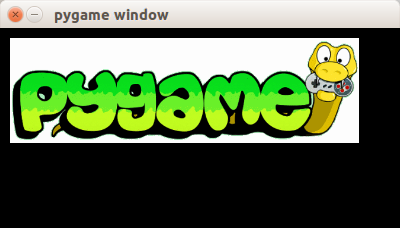pygame
Python hosting: Host, run, and code Python in the cloud!

Dive deep into building games using Pygame. Harness the power of Python and create cross-platform games that run seamlessly on Windows, Linux, and Mac OS.
Learn the essentials of game development with Pygame, starting from the foundational framework. As we progress through this tutorial and the subsequent ones, we’ll delve into the intricacies of creating various game types.
Recommended Reading: Create Space Invaders with Python
Grasping the Basics with Pygame
After finishing this segment, you’ll produce a game akin to the one showcased here.
All games, regardless of their complexity, follow a foundational structure:
- Initialization of resources (graphics, sounds, levels, and data).
- Continuous running until a termination event occurs.
- Within this loop, the game’s logic is updated, user input is gathered, and the screen visuals are refreshed.
This universally accepted structure in game development translates to the following pseudo code:
1 | initialize() |
Implementing this in Pygame, we get:
1 | import pygame |
Here’s a breakdown:
- The Pygame program initiates with the
__init__()method. - The
on_execute()method, responsible for the game’s core operations, is invoked. - Game termination and cleanup occur in the
on_cleanup()method. - During initialization (
on_init()), we define the game’s resolution and initialize the Pygame library. - Images are loaded in but not displayed immediately. This action is reserved for the
on_render()method.
The blit method sketches the image (image_surf) onto a specific coordinate (x,y). In Pygame, coordinates begin at (0,0) (top-left) and span to (windowWidth, windowHeight). The call to pygame.display.flip() refreshes the game screen.
Further Reading: Create Space Invaders with Python
Ready to further your knowledge and grasp game logic? Dive into the next tutorial to continue this exciting journey of game creation with Python!

Leave a Reply:
Thanks! Making games is something I always wanted t
a whack at, Python/PyGame may just bring that within reach
Glad to help! Do you wish to know about any specific type of game?
I was on the python beginner tutorials and somehow ended up here after the polymorphism stuff. There's too much new stuff here that I don't think I'm ready for. Where do I go from polymorphism?
On which concepts would you like more tutorials? I'll write them if you let me know. You could try the network tutorials or the Tk (gui) tutorials that I'll upload in a second.
I want to learn any concepts that will be useful in getting me an entry level job without a bachelor's degree.
Hi Jordan, I'll add more tutorials which will be helpful in achieving your goal :-)
A jump-n-run in the line of Bruce Lee - C64 style :)
Added a short tutorial on jump-n-run logic.
Thankzzzzz :)
First of all, nice job ! Started off with Python game programming myself, with the help of this tutorial. There is one thing I do not understand though.
def on_execute(self):
if self.on_init() == False:
self._running = False
on_init has no return value defined, how are you able to check on_init() for False?
Would appreciate an answer :)
Hi Phil, thanks! At present that statement is not reachable. You could make on_init() return a value in case the game data loading fails. When calling pygame.init(), any errors will cause an exception. You can call pygame.display.get_init() which returns True if the display has been initialised.
Hi Frank!
, i need to make a dynamic GUI on python. It is for simulating a horizon indicator in which the horizon plane translates and rotates showing roll and pitch. i have made a static GUI in PYQT using different Widgets and now i am stuck. can you please guide how can i show pich and roll movements.
Sure, could you post your code?